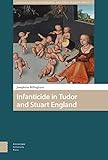Infanticide in Tudor and Stuart England / Josephine Billingham.
Material type: TextSeries: Gendering the Late Medieval and Early Modern World ; 8Publisher: Amsterdam : Amsterdam University Press, [2019]Copyright date: ©2019Description: 1 online resource (350 p.)Content type:
TextSeries: Gendering the Late Medieval and Early Modern World ; 8Publisher: Amsterdam : Amsterdam University Press, [2019]Copyright date: ©2019Description: 1 online resource (350 p.)Content type: - 9789048538164
- Infanticide -- History -- England
- AUP Wetenschappelijk
- Amsterdam University Press
- Early Modern Studies
- Gender and Sexuality Studies
- History, Art History, and Archaeology
- Literary Theory, Criticism, and History
- Sociology and Social History
- HISTORY / Europe / Great Britain / Tudor & Elizabethan Era (1485-1603)
- Infanticide, liminality, pregnancy, childbirth, punishment
- 364.1/523
- online - DeGruyter
| Item type | Current library | Call number | URL | Status | Notes | Barcode | |
|---|---|---|---|---|---|---|---|
 eBook
eBook
|
Biblioteca "Angelicum" Pont. Univ. S.Tommaso d'Aquino Nuvola online | online - DeGruyter (Browse shelf(Opens below)) | Online access | Not for loan (Accesso limitato) | Accesso per gli utenti autorizzati / Access for authorized users | (dgr)9789048538164 |
Browsing Biblioteca "Angelicum" Pont. Univ. S.Tommaso d'Aquino shelves, Shelving location: Nuvola online Close shelf browser (Hides shelf browser)

|

|

|

|

|

|

|
||
| online - DeGruyter The Power of Religious Societies in Shaping Early Modern Society and Identities / | online - DeGruyter Pope Benedict XII (1334-1342) : The Guardian of Orthodoxy / | online - DeGruyter The Celestine Monks of France, c. 1350-1450 : Observant Reform in an Age of Schism, Council and War / | online - DeGruyter Infanticide in Tudor and Stuart England / | online - DeGruyter Fictions of Containment in the Spanish Female Picaresque : Architectural Space and Prostitution in the Early Modern Mediterranean / | online - DeGruyter Mysteries of Cinema : Reflections on Film Theory, History and Culture 1982-2016 / | online - DeGruyter Mapping the Digital Divide in Africa : A Mediated Analysis / |
Frontmatter -- Contents -- Acknowledgments -- Author’s notes -- 1. Losses, Lacunae and Liminality -- 2. European and Medieval Contexts of Infanticide -- 3. The Liminal Child and Mother -- 4. Love, Law and Liminality -- 5. Constructing Outsiders, Constructing Killers -- 6. Not the Usual Suspects: Communities and Accomplices -- 7. Not the Usual Suspects: Married Women -- 8. Not the Usual Suspects: Men -- 9. Interlude: Infanticide 1700–1950 -- 10. Epilogue: Echoes of the Past -- Appendix 1. The 1624 Infanticide Act -- Appendix 2. Note on Sussex Coroners’ inquests -- Appendix 3. Sussex Cases of Violent, Unnatural, Unexplained Infant Death 1547–1686 -- Appendix 4. Sussex Infant Deaths Involving Water -- Appendix 5. Sussex Infant Deaths Involving Throwing -- Appendix 6. Sussex Infant Deaths Involving Bloodshed or Extreme Violence -- Appendix 7 Sussex Infant Deaths Showing Direct Involvement of Men -- Index
restricted access online access with authorization star
http://purl.org/coar/access_right/c_16ec
Infanticide in Tudor and Stuart England explores one of society’s darkest crimes using archival sources and discussing its representation in the drama, pamphlets and broadside ballads of the early modern period. It takes the reader on a journey through the streets and taverns where street literature was hawked, to the playhouses where the crime was dramatized, and the courts where it was tried and punished. Using a regional microstudy of coroners’ inquests and churchwardens’ presentments, coupled with theories of liminality, marginality and rites of passage, it reveals complex and contradictory attitudes to infants, women and the crime. As well as considering unwed women, the most common perpetrators of infanticide, the study shows that married women, men and the local community were also culpable, and the many reasons for this. Infanticide in Tudor and Stuart England is set in its European and historical contexts, revealing surprising continuities across time.
Mode of access: Internet via World Wide Web.
In English.
Description based on online resource; title from PDF title page (publisher's Web site, viewed 25. Jun 2024)


